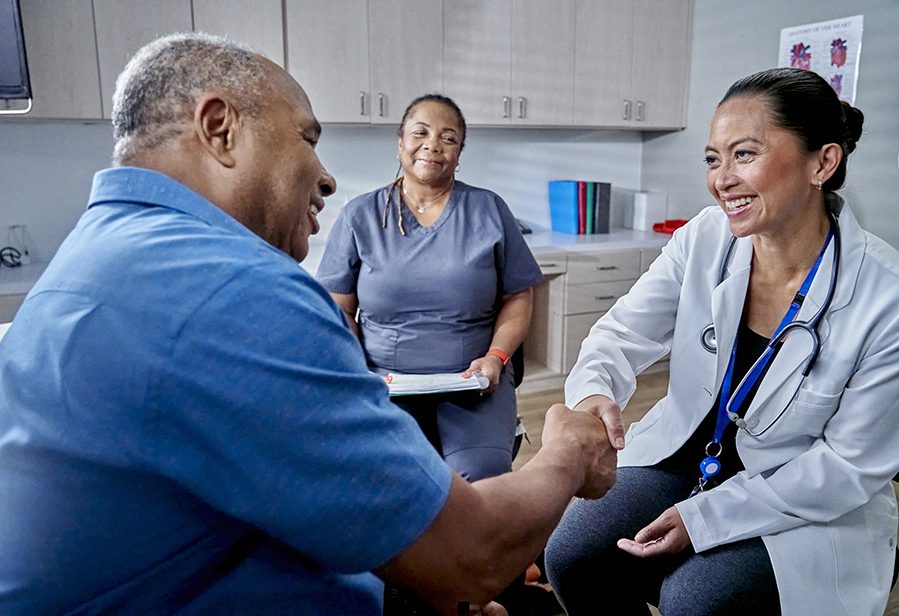For seniors, respiratory diseases are often more complex, and typically more dangerous than in younger people. This makes understanding the symptoms of common respiratory diseases important, since in most cases, early detection and treatment is essential in helping you live your longest, fullest, most productive life possible.

The 16 Most Common Respiratory Diseases for Seniors
1. Asthma
One of the most common respiratory diseases for seniors is asthma, a condition characterized by wheezing, tight chest, difficulty breathing, and a dry, hacking cough. It occurs when the lungs’ airways become inflamed to the point that breathing is difficult. This is usually the result of an allergic reaction to a “trigger,” such as pollen or smoke.
Though asthma usually starts in childhood, adult onset asthma can affect people in their 60’s and older.
Fortunately asthma is reversible, and those with it can often lead normal, active lives so long as they get the right treatment.
2. COPD
Chronic compulsive pulmonary disease, or COPD, is a blanket term coveing a variety of diseases that damage the lungs and limit one’s ability to exhale normally. It’s characterized by shortness of breath, an inability to perform physical activity without becoming winded, and a phlegm producing cough, especially upon rising in the morning.
Like asthma, it affects the airways, though due to it often taking years to develop, it can be difficult to diagnose. It’s often mistaken for the gradual aging and natural deterioration of lung function, though this progressive disease has irreversible consequences that can worsen to the point of making even everyday activities difficult.
While usually associated with tobacco smoke, air pollution and other types of smoke and airborne particulate can also cause it.
3. Chronic Bronchitis
Another form of chronic lung disease in the elderly that affects the airways is chronic bronchitis, which produces symptoms that normally include a chronic, wet, productive cough. This is due to increased activity in the mucus glands of the airways, especially in the morning.
Though different from acute bronchitis which is a temporary bacterial infection, chronic bronchitis is a form of COPD that will continue to worsen, especially without treatment.
4. Acute bronchitis
Acute Bronchitis is normally a temporary bacterial infection or viral infection. For Bacteria alone, it can cause an infection of the airways that causes excess mucus to form which then needs to be expelled through coughing, acute bronchitis can eventually become chronic if attacks are recurring. This is especially true for smokers or others who are exposed to air contaminants causing their condition.
5. Emphysema
Commonly caused by smoking, emphysema is a dangerous disease that affects the airways and air sacs (aveoli) in the lungs, making exhaling difficult or impossible. It’s a form of COPD that occurs progressively when alveoli can’t repair themselves from exposure to contaminants.
Unfortunately, emphysema takes years to develop, and has no cure. The best advice for any smoker is to quit as soon as possible to ebb its worsening symptoms.
6. Lung Cancer
This leading cause of death in the US for both men and women not only affects the air sacs of the lungs, but if left unchecked, it can spread throughout the body. It’s also difficult to detect, and can start in any area of the lungs when DNA mutations cause irregular cells to multiply uncontrollably.
Its symptoms can take years to develop, and may include a chronic cough, wheezing, changes in voice, and coughing up blood.
Along with smoking and secondhand smoke, it can be caused by exposure to asbestos, diesel exhaust, radon, radiation, and other airborne contaminants
7. Cystic Fibrosis
Cystic fibrosis is a genetic condition that clogs the airways of sufferers with thick, sticky mucus that leads to dangerous and recurring bacterial infections in the lungs. It also obstructs the pancreas, which inhibits nutritional uptake.
Though most cases are diagnosed by age 2, around 25% of cases go undetected and are characterized by salty-tasting skin, poor growth when young, a chronic cough, and frequent lung infections.
8. Tuberculosis
Caused by exposure to the mycobacterium tuberculosis bacteria, tuberculosis is a form of pneumonia that affects the lung’s alveoli, or air sacs. It’s also highly contagious, and can spread to other areas of the body including the spine and brain.
Though it was once the leading cause of death in the US, most cases are now cured with antibiotics, with treatment usually taking between 6 & 9 months.
9. Pulmonary Edema
Pulmonary edema is a disease affecting the lung’s alveoli and interstitium, which are the thin linings between the alveoli. It occurs when fluid leaks from blood vessels into the areas surrounding the alveoli, making it difficult to breath.
It’s caused by either back pressure in the lungs due to heart failure, or when an injury to the lungs damages blood vessels and causes them to leak.
10. Pulmonary Embolism
This disease affecting blood vessels is caused when a blood clot (usually from deep in a leg vein) breaks off and travels to the heart, and then into the pulmonary arteries of the lungs. This causes shortness of breath and low oxygen levels since the pulmonary arteries are responsible for carrying blood into the lungs to distribute oxygen through the body, which can’t occur efficiently when the arteries are blocked.
11. Pulmonary Hypertension
This life threatening condition affects the pulmonary arteries and causes high blood pressure. Though it may be genetic, doctors don’t always know the cause, which may include blood clots, congestive heart failure, drug use, sleep apnea and other diseases.
Though symptoms may not occur immediately, they worsen over time and include shortness of breath during activity, chest pains, fatigue, and swelling of the ankles.
12. ARDS
Acute respiratory distress syndrome, or ARDS, is the sudden, severe damage to the alveoli caused by serious illness such as COVID-19. It can be life threatening, and often requires the use of a ventilator during the recovery process.
13. Pneumonia
Pneumonia is a bacterial, viral, or fungal infection that causes the alveoli and interstitium areas of the lungs to fill with fluid, making it difficult to breath. Symptoms include fever, chills, shortness of breath, and a chronic, wet, painful cough.
Seniors, particularly those who smoke or have other chronic disease, are especially susceptible to this life-threatening illness. For those over age 65 with chronic illness, a pneumococcal pneumonia vaccine along with flu shots, hand washing, and extra care during cold and flu season is strongly recommended.
14. Pleural Effusion
Pleural effusion occurs when the pleural space between the lungs and chest fill with fluid to the point breathing becomes difficult. This can be caused by a variety of reasons, including congestive heart failure, cancer, or pneumonia, and it’s usually diagnosed when a patient complains of shortness of breath and increased chest pain.
15. Pneumoconiosis
Pneumoconiosis is a category of conditions in which damage to the alveoli occurs as the result of inhaling foreign matter, such as when coal dust results in black lung disease. Other forms of the disease include asbestosis and silicosis from inhaling asbestos or silica dust, respectively, and it may also occur from continuously breathing aluminum, antimony, barium, graphite, iron, kaolin, mica, talc or other types of airborne particulate.
It’s also a progressive conditions that may not show symptoms at first which, in severe cases, results in breathing impairment, loss of ability to perform routine physical acts, and death.
16. Interstitial Lung Disease (ILD)
The interstitium is the delicate lining between the lung’s alveoli that can become scarred or inflamed as the result of breathing harmful substances, certain health disorders, genetics, or other unknown causes. When this happens, the affected tissues become hardened and stiff resulting in a dry, non-productive cough, shortness of breath, fatigue, weight loss, and an inability to perform physical activities.
What About COVID-19?
Unknown in humans prior to 2019, COVID-19 is a viral infection that causes illness affecting the respiratory system. It is easily spread through close, unprotected contact, and is particularly dangerous for seniors, who’s risk of severe illness and death increases with age. Currently, 8-out of 10-COVID-19 related deaths are those 65-or-older.
Though its primary symptoms are flu-like and may include cough, fever, and shortness of breath, it can worsen to the point a ventilator is necessary to enable breathing. It’s also important that seniors in particular observe all safety precautions during this life-threatening outbreak, including:
- Wearing a mask whenever you’re around others
- Staying away from crowds and avoiding public areas
- Frequently washing your hands using either soap and hot water, or a sanitizer containing at least 60% alcohol
- Using a 60% alcohol based sanitizer to sanitize surfaces
- Avoiding touching areas of your face including eyes, mouth, and nose
- Getting in touch with your provider at the first sign of illness
You should also consider using home delivery services to shop without leaving your home, and though isolation may cause you to feel lonely or depressed, it’s important that you avoid holiday and other large family gatherings.
To help alleviate loneliness (which is important!), you can meet with friends and family members online using video conference software, or consider phone conversations, letter writing, or other means of staying in touch that don’t involve close physical proximity.
Questions for Your Provider
If you’re a senior diagnosed with lung disease, there are some questions to be sure to ask your doctor:
- How will travel affect my condition?
- What lifestyle changes do I need to make?
- Can I still exercise?
- What symptoms should I be aware of?
- What support resources are available to me?
- What medications will I need, and what are their’s and my condition’s side effects?
Asking these and any other questions you may have will help your doctor form the most comprehensive treatment plan possible, and it can also help relieve you of the anxiety of not fully understanding your condition.
Why Choose Intermountain Health?
If you’re elderly with symptoms of respiratory disease, you need immediate, convenient, premier-quality healthcare, which is where Intermountain Health comes in. That’s because we provide only the safest, most effective, and compassionate respiratory care there is, no matter if you’re experiencing a life-altering disease, or just need to know how to prevent any from occurring. Our award winning medical professionals are specially trained to put your needs first each and every time you visit one of our many convenient locations throughout the state.
This includes a complete spectrum of care for seniors who, along with being the most vulnerable members of our society, deserve the compassion they’ve earned.
At Intermountain Health, no matter your age or healthcare need, we’re always here for you.
*This article is for informational purposes only and is not intended to be a substitute for medical advice or diagnosis from a physician or qualified healthcare professional.





